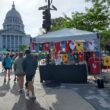Community support makes trail a reality
The idea of a parkway along Utah’s Virgin River had been around for years. But it was repeatedly rejected, primarily because of local landowners who feared a loss of privacy and control.
It was not until several communities decided to create their own trails and work with local landowners to find acceptable routes that would connect into one coordinated system that the idea took off. The Three Rivers Trail is the product of those efforts, and, when it is complete, it will stretch about 80 miles from Zion National Park across Washington County to the Gunlock Reservoir.
Most of the primary trail parallels parts of Ash Creek and the Virgin and Santa Clara rivers. Numerous parks, recreation areas and historic sites are located along the corridor. It encompasses three distinct regions: the Colorado Plateau, known for its rugged red rock landscape; the Great Basin Desert, characterized by juniper, scrub and rocky basalt crags; and the Mojave Desert, notable for its Joshua trees and unique wildlife.
Despite the obvious benefits of creating a trail through such scenic country, the idea never would have become reality without the cooperation of dozens of entities. The city of St. George took the lead in the trail project, acquiring trail easements from willing landowners and building several miles of trails. Those trails were so popular that other Washington County communities were convinced to give it a try.
In 1995, representatives from communities across the county met and, after a lively discussion, decided that the trail idea had merit, but only if it was locally controlled and respected private property rights. Each community designated a trail coordinator, who meets regularly with other community representatives to coordinate trail planning and funding efforts.
The process involved the county, St. George, Santa Clara, Washington City, Hurricane City and LaVerkin City, the towns of Ivins; Leeds, Toquerville; Rockville and Springdale; local Native Americans; numerous state, federal and local agencies; and private organizations.
When it is complete, the trail will provide access to a number of cultural, historic and scenic locations, including:
– the Red Cliffs Desert Reserve, a scenic 61,000-acre desert established to protect the threatened Mojave desert tortoise and other sensitive wildlife;
– Zion National Park, internationally known for its distinctive beauty;
– an old corral built by the Civilian Conservation Corps during the Great Depression;
– Grafton, a popular pioneer ghost town;
– the confluence of the Virgin River with Ash and LaVerkin creeks;
– St. George Central Park and the Santa Clara River confluence;
– Tonaquint Nature Center; and
– the Santa Clara River Reserve, which highlights examples of Virgin River Anasazi rock art.
More importantly, it also will encourage a sense of community – and a meeting place – in the diverse area. “Community trails promote greater social interaction as members of the community chance upon one another in relaxed informal settings,” says Washington County Trail Coordinator Lori Rose. “When trails are linked to adjacent public lands or areas of native habitat, people enjoy the opportunity to see the region’s unique wildlife and scenic backcountry.”



















